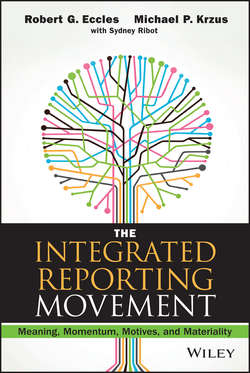Читать книгу The Integrated Reporting Movement - Eccles Robert G. - Страница 5
На сайте Литреса книга снята с продажи.
Preface
ОглавлениеMany exciting developments have taken place since we published the first book on integrated reporting (One Report: Integrated Reporting for a Sustainable Strategy) four years ago. The International Integrated Reporting Council (IIRC) was formed in 2010 and the Sustainability Accounting Standards Board (SASB) in 2011. Global Reporting Initiative (GRI) released its G4 Guidelines in 2013, the same year the Climate Disclosure Standards Board (CDSB) updated its Reporting Framework and announced plans to expand the scope of its Framework to include other natural resources and the IIRC published “The International <IR> Framework” (<IR> Framework). Other important events include the launch of the UN-sponsored Sustainable Stock Exchanges Initiative (SSE) in 2009 and the Corporate Sustainability Reporting Coalition (CSRC), sponsored by Aviva Investors, in 2011.
For these and many other reasons, we decided that now was the time to take stock of the integrated reporting movement. We very consciously use the term “movement” to describe what is happening with integrated reporting today. Its members include companies, investors, supporting organizations and initiatives, and firms that supply products and services to help companies produce an integrated report. With the exception of South Africa, no country has made any kind of regulatory intervention in support of integrated reporting. The bulk of adoption today is being accomplished through a social movement. The people and organizations involved see integrated reporting as an essential, but certainly not sufficient, mechanism to help companies create more sustainable strategies to support investors making longer-term investment decisions that, together, will support the creation of a sustainable society. Just as financial reporting played a critical role in creating the capital markets we have today, integrated reporting, supported by sustainability reporting, will help create the capital markets and society we need for tomorrow.
Chapter 1 is a case study on the emergence of integrated reporting in South Africa. Members of the movement are well aware of the country's leadership here, but they may not know the full story of how this country became the first and only one so far to require integrated reporting on an “apply or explain” basis. Chapters 2 through 4 review the state of the integrated reporting movement today. Although the topics in these chapters will be familiar to those involved in the promotion of integrated reporting, we examine them through the lens of a movement. Chapter 2 posits four overlapping phases for how meaning has evolved, starting with company experimentation, through early commentary, up to codification, and ending with the recent start of institutionalization. Chapter 3 examines the movement's momentum in terms of adoption, acceleration, and awareness, and Chapter 4 analyzes the motives of the different types of actors involved.
Chapter 5 focuses on materiality – a core, albeit elusive, concept in integrated reporting and reporting in general. Chapter 6 looks at efforts companies have made to operationalize it through a “materiality matrix.” To the extent that this book attempts to break new conceptual ground, this is the work of Chapter 5, where we introduce the idea of an annual board “Statement of Significant Audiences and Materiality” (Statement) and 6, where we describe the “Sustainable Value Matrix” (SVM) as a tool for translating this statement into management decisions. Through the Statement, the company makes clear its purpose vis-à-vis providers of financial capital and other stakeholders. The SVM provides guidance to management on reporting, stakeholder engagement, resource commitments, and opportunities for innovation.
In Chapter 7, we assess the quality of integrated reporting prior to the publication of the International <IR> Framework through a careful analysis of the self-declared integrated reports of 124 companies. In Chapter 8, we do the same for the corporate reporting websites of the largest 500 companies in the world. These two chapters set the stage for Chapter 9, which discusses the role of information technology (IT) in integrated reporting and how it can be used to promote integrated thinking. We believe that the movement needs to be more cognizant of the importance of IT, and this chapter seeks to place this topic at the center of the conversation.
In our final chapter, we make four recommendations for what needs to be done to ensure the success of the movement. The first concerns the role the IIRC can play in certifying the quality of integrated reports. The second describes how best to marshal market and regulatory forces to spur the adoption of integrated reporting, and our last two recommendations focus on organizations, clarifying the role of accounting firms and professional accounting associations and emphasizing the need for the major NGOs supporting the movement (CDP, GRI, and the SASB) to collaborate as much as possible.
As we submit this book to our publisher in May of 2014, how do we feel about the integrated reporting movement? Cautiously optimistic. That said, the future is not predetermined. It is there to be shaped. We will continue to do everything we can to support the movement in our own modest way, and we encourage all who care about creating a sustainable society to do the same.
